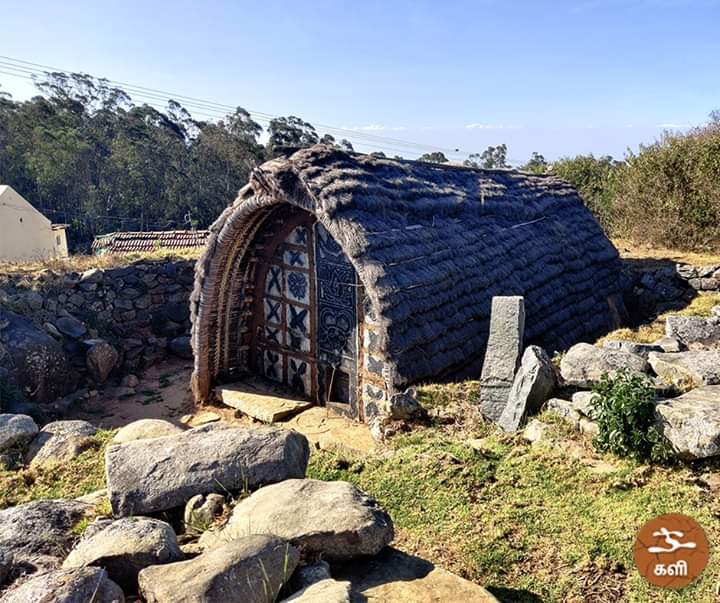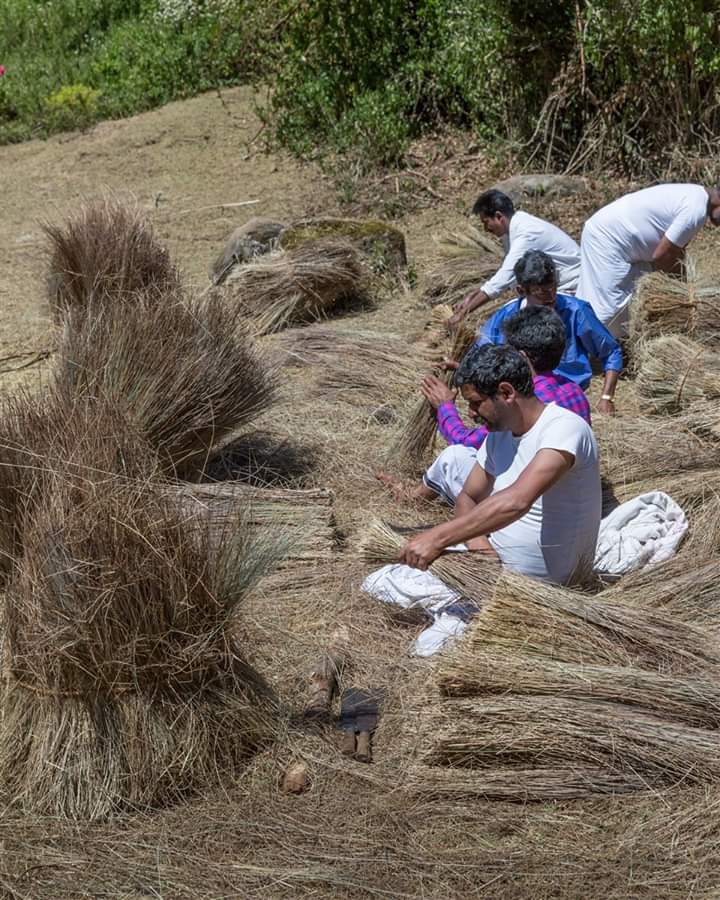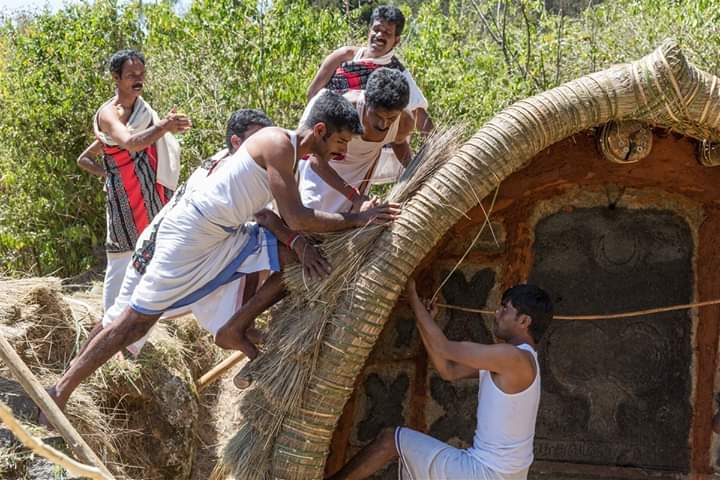https://www.facebook.com/groups/1536366159917167/permalink/2587927771427662/?sfnsn=mo
The Aboriginal Toda Architects of the Blue Mountains
The Aboriginal Toda Architects of the Blue Mountains
1
INDIGENOUS people around the world are known to lead PRISTINE LIFESTYLES, united with nature. Their traditions DEEPLY RESPECT their habitat and many of their practices help to Conserve Biodiversity and Natural resources. HEREDITARILY, they are aware of the ill-effects their children will face, if they take a step against natural laws. Their customary designs and techniques of building shelters were also made consciously with local materials that are CLIMATE-RESISTANT. Let us look at one such tribe of Tamilnadu, India.
Toda is a PASTORAL aboriginal hill tribe of the Nilgris of Tamilnadu. They are among one of the oldest tribes of India, with each tribe known to have owned hundreds of buffaloes, that were the fundamental part of their lives. All their land, resources, and their buffaloes belonged to nobody and everybody. The Todas were the best living examples of COMMUNITY SELF-SUSTENANCE.
Among the five Thinais of Landscapes, (Sangam Landscapes) Nilgiris or the Blue Mountains classifies under the Kurinji land. This Kurinji land of Nilgiris is characterized by the mountains of the Western Ghats they are situated among. Unusual to the tropical WARM-HUMID CLIMATE of Tamilnadu, Nilgiris is a perfect example of a unique South Indian Cold Climate, that is all through the year surrounded by the cold and frost. Here, the rainy seasons of June to September are accompanied by high Winds along with high humidity.
The Todas were KEEN WORSHIPPERS OF NATURE, religiously worshipping the five elements. As a clan, the Todas were strictly vegetarian, they never hunt or WAGE WARS. Their STAPLE FOOD depended on both forest produce as well as cultivation. They cultivated a wide-range of CLIMATE-RESILIENT MILLETS like Foxtail millet, little millet, Ragi, Pearl millet, local vegetables, varieties of mountain rice, gathered spices, honey, and fruits. Their traditional clothing is a single piece of cloth that they wrap around their body. The Toda Women EMBROIDER their own CLOAKS with VIBRANT RED AND BLUE MOTIFS. In a place where even their language is unique, it is also inevitable that their buildings are distinct too. The Todas built their own structures together as a community from LOCALLY SOURCED MATERIALS.
2
Natural Buildings of the Todas
The Todas are spread around the mountains as different HAMLETS with each hamlet having RESIDENCES, TEMPLES, AND BUFFALO PENS. Such a Toda settlement is called a Mund. We visited one such settlement called Thalakundha, where the ancient tower temple of “Muthanadu Mund” stands.
They build mainly two forms of structures –1. Arch buildings - called Moonbo and 2. Conical Temples(Gopura) - called Pozhvoash. The Arch building dominantly acts as a residential unit, but exceptionally in a few places, you can find arched temples. Conical structures are exclusively sacred temples. Till today, the Toda temples remain UNALTERED.
The natural buildings of the Toda are very minimal, hand-crafted, and CLIMATE-RESPONSIVE. Their main sources of building materials were wood, stones, bamboo, CANES, RATTAN, Thatch reeds, mud, and BUFFALO DUNG. All these materials were WITHIN THEIR REACH and everybody in the community still possesses the manual skills to construct a new one.
The arch structures are about 18ft [5.49 m] long by 9ft [2.74 m] wide and 10ft [3.95 m] tall in dimension. The front and the rear are covered with large pieces of stones with only a small door. Originally, this was done with wood, however, that practice has now become OBSOLETE.
The structure on top of these stones is a BARREL-VAULT, constructed with bamboos and canes that are LASHED WITH RATTAN. Bamboo REEDS are bundled to give HIGH TENSILE STRENGTH that holds the whole structure together. Finally, the area is covered with thick dried thatch called the Avful, a type of Tussock Grass.
In this house, they have 3 areas separate for different activities of cooking/fireplace, eating, and sleeping. They have a small storage space as well as a different space for POUNDING GRAINS. The toda houses had a raised sitting platform (Thinnai) outside for socializing.
3
All the structures of the Toda Settlement face their entrance North-East to receive the most morning sun. The half Barrel shape naturally acts stable against the high wind flow.
The structure has a small opening at the bottom of the barrel about 3ft by 3ft [0.91 m] in which a person has to BEND LOW to enter. In the kurinji land, there were always threats of wild animals including elephants, tigers, bears, and monkeys. This way of scarce openings was essential to keep themselves protected from wild animals. The fireplace inside is used to heat the interiors. The openings, stone, and thatch would not let the smoke escape out easily, keeping them warm at all times. The small openings also ensured individual privacy from outside.
Apart from this method of construction, WATTLE AND DAUB TECHNIQUES are also common here. Building walls with STONE AND CLAY AND POLES have been habitual.
The Todas have very ancient meaningful MOTIFS AND MURALS. All over the walls of the Toda temple, symbols are drawn to indicate the sacred buffalo and the cosmic circle. Each of their motifs drawn on their structures have meanings related to Nature and the daily cycle of life.
Today due to many interventions and changes, the Toda settlements are completely converted to concrete and tile roof houses. At present, about 1500 todas remain with SCARCE FEW* ["a scarce of a very few" in the article sends to be wrong] buffaloes. The todas have become a part of the local people of Ooty and taken to modern life. They gather annually during their ceremonies or in OCCURRENCES of family functions and CHERISH THEIR CULTURE and practices.
*https://ludwig.guru/s/scarce+few
VOCAB:
1
pristine lifestyle
hereditarily
climate-resistant
pastoral
ucommunity self-sustenance
warm-humid climate
keen worshippers of nature
to wage wars
staple food
climate-resilient millet
cloaks
vibrant red and blue motifs
locally sourced material
keen worshippers of nature
to wage wars
staple food
climate-resilient millet
cloaks
vibrant red and blue motifs
locally sourced material
2
hamlet
residence
temple
buffalo pen
unaltered
climat-responsive
canes
within their reach
obsolete
barrel-vault
lashed with rattan
Bamboo reeds
high tensile strength
pounding grains
3
bend low
wattle and daub technique
stone and clay and poles
motifs and murals
scarce few
occurrence
cherish




















No comments:
Post a Comment